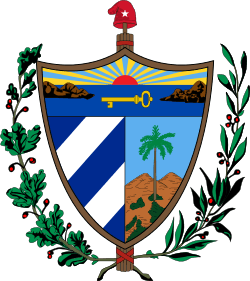Brazzaville Protocol
| Agreement between the Government of the Republic of Cuba and the Government of the People's Republic of Angola for the Conclusions of the Internationalist Mission of the Cuban Military Contingent | |
|---|---|
| Type | peace treaty |
| Context | Cold war |
| Signed | 13 December 1988 |
| Location | Brazzaville, Republic of the Congo |
| Signatories |
Isidoro Malmierca Peoli (Foreign Minister of Cuba) Afonso Van-Dunem (Foreign Minister of Mozambique) |
| Parties |
|
| Languages | |
The Brazzaville Protocol (Official name; Agreement between the Government of the Republic of Cuba and the Government of the People's Republic of Angola for the Conclusions of the Internationalist Mission of the Cuban Military Contingent[1]) mandated the withdrawal of Cuban troops from Angola, paving the way for Namibia's independence through the New York Accords.[2] Representatives from the governments of Angola, Cuba, and South Africa signed the protocol on December 13, 1988 in Brazzaville, Congo.[3]
Negotiation

In 1981 Chester Crocker, U.S. assistant secretary of state for African affairs for newly elected President Ronald Reagan, had developed a linkage policy, tying apartheid South Africa's agreement to relinquish control of Namibia to Cuba's troop withdrawal and peace in Angola.[3][4]
During the summer of 1986, a first informal meeting was organized by French businessman Jean-Yves Ollivier and French president's counselor for African affairs Jean-Christophe Mitterrand between senior South African, Mozambican and Angolan representatives in the Kalahari Desert.
On September 10, 1986 Fidel Castro made Crocker's proposal a prerequisite to withdrawal from Angola as did the South African government by August 30, 1988. The Angolan and American governments began negotiating in June 1987. The Cuban government joined negotiations on January 28, 1988 and all three parties held a round of negotiations on March 9 in London. The South African government joined negotiations on May 3 and the parties met in June and August in New York City and Geneva. All parties approved an outline agreement of Principles for a Peaceful Settlement in South Western Africa on July 20[5] and agreed to a ceasefire on August 8, 1988.[6]
UNITA and South African forces stopped and repelled an MPLA advance on UNITA regions in strongholds in Southern Angola ending with the Battle of Cuito Cuanavale in Cuando Cubango province from January 13 to March 23, 1988, in the second largest battle in the history of Africa.[7] UNITA and South Africa retreated after a 15-hour battle on March 23 and moved for negotiations.[3][8]
See also
External links
- Full text of the Brazzaville Protocol, UN Peacemaker
- All peace agreements for Angola, UN Peacemaker
References
- ↑ "Protocol of Brazzaville". United Nations.
- ↑ Kahn, Owen Ellison (1991). Disengagement from Southwest Africa: The Prospects for Peace in Angola and Namibia. p. 225.
- 1 2 3 Tvedten, Inge (1997). Angola: Struggle for Peace and Reconstruction. pp. 38–40.
- ↑ COLD WAR Chat: Chester Crocker, Former U.S. Assistant Secretary of State for African Affairs CNN
- ↑ Agreement Among the People's Republic of Angola, the Republic of Cuba, and the Republic of South Africa
- ↑ Alao, Abiodun. Brothers at War: Dissidence and Rebellion in Southern Africa, 1994. Pages XIX-XXI.
- ↑ George, Edward. The Cuban Intervention in Angola, 1965-1991: From Che Guevara to Cuito Cuanavale, 2005. Page 1.
- ↑ Kahn, Owen Ellison. Disengagement from Southwest Africa: The Prospects for Peace in Angola and Namibia, 1991. University of Miami Institute for Soviet and East. Page 79.
